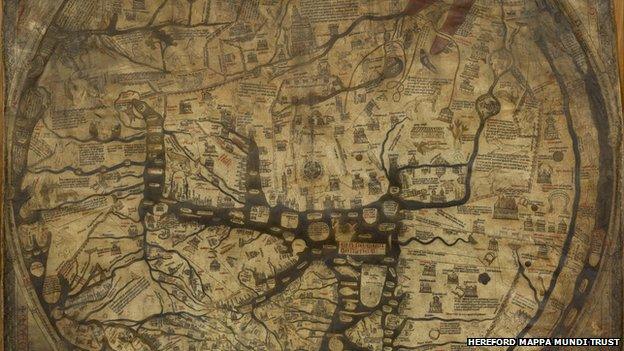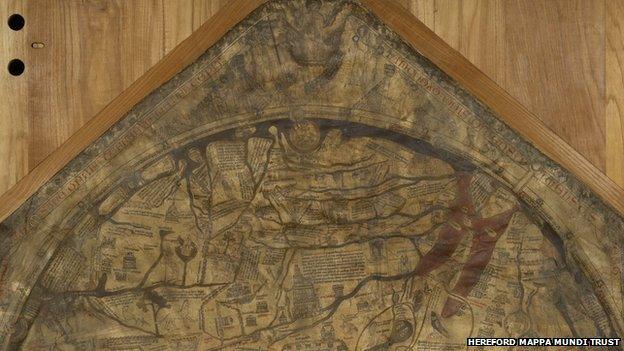Hereford Cathedral lays claim to Mappa Mundi's origins
- Published

Hereford Cathedral says its map is the largest of its kind still in existence
A medieval map of the world that was believed to have been made miles away from the cathedral where it is on display may have been created closer to home.
Hereford Cathedral said its 700-year-old Mappa Mundi, the largest such map in existence, was made in Hereford, not Lincoln as previously thought.
The cathedral said it had scientific evidence to back up its claim.
Lincoln Cathedral said it was "interested" in the research.
'More evidence'
The circular map is 52in (132cm) in diameter and shows a medieval view of the world with Jerusalem at the centre.
The map, which has been dated to about 1300, features the name of its author Richard of Haldingham or Lafford - believed to be the town of Sleaford, in Lincolnshire.

A compass hole in the map corresponds to a hole in the wood suggesting, the cathedral says, it was made in Hereford
However, the cathedral's education officer Sarah Arrowsmith, who has studied the map for 10 years and has written a book on the subject, said she believed Richard died before the creation of the map.
She said tests on the wood in the triptych on which the map was displayed showed it had been grown in the Herefordshire area, while a compass hole in the centre of the map corresponds with a hole on the wood.
"It makes it look as if the map was made in situ," she said. "All the dates add up to suggest there is more evidence it was made in Hereford than Lincoln.
"It may be that there was a map in Lincoln that inspired ours - or it was a copy of an exemplar of some sort - but that's just speculation."
Jackie Croft, chapter clerk and administrator at Lincoln Cathedral, said: "We are always interested to hear about any research being done on Mappa Mundi and its origins, as we are aware from conversations with Hereford Cathedral that there is a Lincolnshire connection.
"As far as we know we do not have a Mappa Mundi in our collections but one can always hope."


The map shows the locations of Paradise and the Garden of Eden
The world as we knew it
Mappa Mundi means "world map" in Latin
Hereford's map shows Paradise, roughly where Japan would be, and the Garden of Eden
The map also shows more than 500 images from nature, history and classical mythology
- Published1 January 2013

- Published4 April 2011